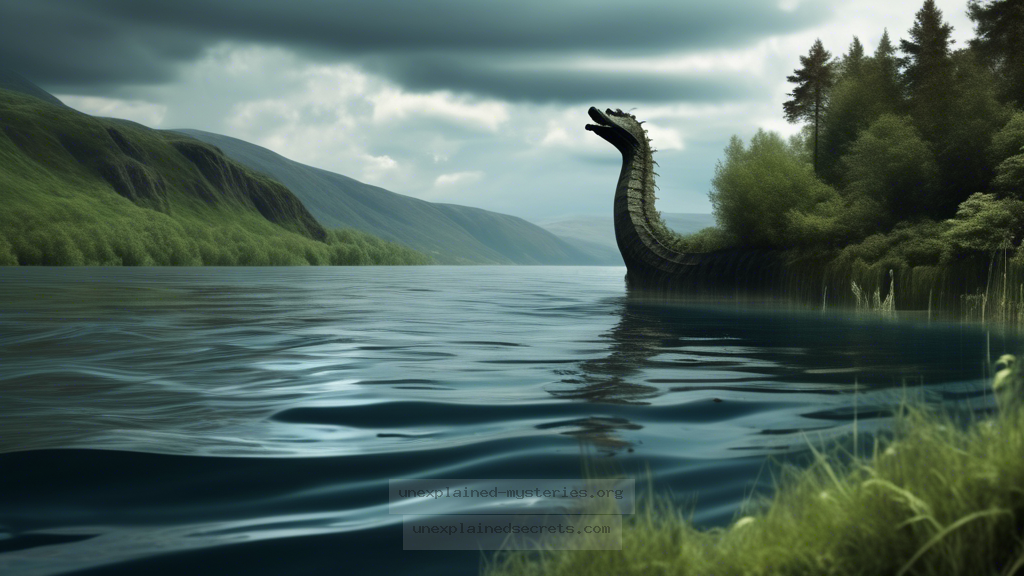What Does Sonar Technology Reveal About the Mysteries of the Loch Ness Monster?
What Does Sonar Technology Reveal About the Mysteries of the Loch Ness Monster?
The Loch Ness Monster, affectionately known as “Nessie,” has captivated the imaginations of people worldwide for decades. With sightings dating back to the 6th century and a plethora of theories surrounding its existence, Nessie represents one of the most enduring mysteries in cryptozoology. Among the various methods used to investigate this phenomenon, sonar technology has emerged as a critical tool. But what exactly does sonar reveal about the elusive creature of Loch Ness? This question matters not just for enthusiasts of the paranormal but also for scientists and researchers seeking to understand the depths of Loch Ness and the creatures that might inhabit it.
Historical Context of Loch Ness Monster Sightings
The legend of the Loch Ness Monster began in earnest in the 1930s when a photograph known as “The Surgeon’s Photo” captured the public’s imagination. This photograph, taken by Robert Kenneth Wilson in 1934, purportedly showed a creature rising from the depths of the loch. Although later revealed to be a hoax, it sparked a wave of interest and numerous subsequent sightings. Eyewitness accounts have included descriptions of a large, long-necked creature, which has led many to speculate about its identity—ranging from a surviving plesiosaur to a giant eel.
However, the Loch Ness Monster’s lore stretches back even further. The first recorded sighting dates back to 565 AD, when St. Columba purportedly encountered a “water beast” in the loch. Since then, the frequency and nature of sightings have varied, but they have consistently fueled public fascination and scholarly inquiry.
Understanding Sonar Technology
Sonar, or Sound Navigation and Ranging, is a technique that uses sound propagation to navigate, communicate, or detect objects underwater. It works by emitting sound waves and analyzing the echoes that return after bouncing off an object. Sonar technology has been used extensively in naval applications, fishing industries, and underwater exploration, making it a valuable tool for investigating the depths of Loch Ness.
Modern sonar systems can create detailed maps of the lake bed, detect fish, and even identify larger underwater objects. This technology has been instrumental in several Loch Ness expeditions, allowing researchers to gather data on the lake’s ecological dynamics and search for any anomalies that could indicate the presence of a large creature.
Key Sonar Investigations of Loch Ness
Numerous sonar surveys have been conducted in Loch Ness, particularly in the last century. One of the most notable was the 1987 “Operation Deepscan,” which involved a fleet of boats equipped with sonar technology scanning the loch in a coordinated effort. The operation covered about 24 square miles of the loch and resulted in several intriguing findings.
Notable Findings from Operation Deepscan:
- Detection of large underwater objects that were not identified.
- Mapping of the loch’s bottom, revealing steep drop-offs and underwater caves.
- Identification of various fish species, including the native salmon and eel populations.
Despite these efforts, no definitive evidence of the Loch Ness Monster has been found. Yet, the echoes of large unidentified objects have sparked further investigations and debates about the existence of a creature lurking in the depths.
Core Concepts: What Sonar Can and Cannot Do
Sonar technology has its limitations, and understanding what it can and cannot do is crucial for interpreting the findings from Loch Ness. While sonar can detect and image objects, it does not provide conclusive evidence of their identity. For example, sonar may identify large shapes or movements but cannot distinguish between a large fish, a submerged log, or a mythical creature.
Moreover, sonar technology can struggle with interpreting images in murky waters, which is often the case in Loch Ness due to sediment and organic matter. The clarity of the images and data can be compromised, leading to misinterpretations.
Comparative Analysis: Loch Ness vs. Other Cryptids
When comparing the Loch Ness Monster to other famous cryptids, such as Bigfoot or the Chupacabra, we see distinct differences in the types of evidence presented. While Bigfoot sightings often rely on photographic evidence or footprints, the Loch Ness Monster has a more substantial focus on underwater phenomena and sonar data.
| Cryptid | Type of Evidence | Common Locations |
|---|---|---|
| Loch Ness Monster | Sonar readings, eyewitness accounts, photographs | Loch Ness, Scotland |
| Bigfoot | Footprints, videos, audio recordings | North American forests |
| Chupacabra | Animal carcasses, eyewitness accounts | Latin America |
This comparative analysis highlights the unique nature of Loch Ness investigations, emphasizing the reliance on sonar technology to uncover the truth behind the myth.
Alternative Perspectives on the Loch Ness Monster
While many enthusiasts firmly believe in the existence of Nessie, scientists and skeptics often provide alternative perspectives rooted in biology and ecology. Some argue that the Loch Ness Monster is a product of folklore, a combination of misidentified animals, and the psychological phenomenon known as pareidolia, where people see familiar patterns in random stimuli.
Furthermore, studies have shown that the loch is home to a diverse range of wildlife, which can account for many of the sightings. For instance, the common otter and various large fish species can create disturbances that may resemble the movements attributed to a large creature.
Key Points on Alternative Perspectives:
- The Loch is home to large fish and otters, which may explain some sightings.
- Folklore plays a significant role in the legend of Nessie, with many stories evolving over centuries.
- The psychological factors influencing perception can lead to misidentifications of natural phenomena.
Common Misconceptions About Sonar and Loch Ness
Misconceptions about sonar technology and its role in Loch Ness investigations abound. For example, many people believe that sonar can definitively identify the Loch Ness Monster, misunderstanding its limitations. Sonar can indicate the presence of large objects, but it cannot confirm their nature. Additionally, some believe that sonar searches have been exhaustive, when in reality, substantial portions of the loch remain unexplored due to its vastness and depth.
Moreover, there is a misconception that sonar equipment is infallible. Various factors, including water temperature, salinity, and sediment levels, can significantly affect sonar readings. Understanding these limitations is essential for a realistic interpretation of sonar data.
Best Practices for Investigating the Loch Ness Mystery
For those interested in investigating the Loch Ness Monster, adhering to best practices can enhance the credibility and accuracy of findings. Here are a few recommendations:
- Utilize a variety of investigative tools, including sonar, underwater cameras, and environmental DNA sampling.
- Document all findings rigorously, including environmental conditions during investigations.
- Engage with local experts and historians to understand the cultural context of the Loch Ness legend.
- Remain open to alternative explanations and be willing to revise hypotheses based on new evidence.
By following these best practices, investigators can contribute to a more nuanced understanding of the Loch Ness phenomenon.
Future Developments and Ongoing Research
The search for the Loch Ness Monster continues, with ongoing studies and technological advancements promising exciting developments. Recent innovations in sonar technology, including multi-beam sonar and autonomous underwater vehicles (AUVs), may provide clearer images and data from the loch’s depths.
Additionally, environmental DNA (eDNA) analysis is rising as a powerful tool in wildlife studies. By analyzing water samples for genetic material, researchers can identify various species inhabiting the loch without requiring direct sighting or capture. This method may yield insights into whether a large, unidentified creature resides in Loch Ness.
Emerging Research Areas:
- Advanced sonar technologies for more detailed mapping of the loch.
- Environmental DNA analysis to identify species present in the loch.
- Collaboration with marine biologists to enhance understanding of aquatic ecosystems.
Conclusion: The Ongoing Mystery of the Loch Ness Monster
While sonar technology has provided intriguing insights into Loch Ness, the mystery of the Loch Ness Monster remains largely unsolved. Historical accounts, scientific expeditions, and the ongoing investigation of sonar data contribute to a rich tapestry of folklore and fascination. Understanding the limitations of sonar and considering alternative perspectives are crucial for anyone engaging in research about Nessie.
The allure of the Loch Ness Monster continues to draw researchers and enthusiasts alike, reminding us that some mysteries may never be fully unraveled. As technology advances and our understanding of aquatic ecosystems deepens, the quest to uncover the truth about Nessie will undoubtedly persist, leaving us to wonder what lies beneath the dark waters of Loch Ness.
Other Articles
Recent Posts
- What Happened to Flight MH370? The Conspiracy Theories That Still Haunt Us
- What Secrets Lurk Within the Walls of the Infamous Trans-Allegheny Lunatic Asylum?
- What Evidence Supports the Existence of Bigfoot in the Pacific Northwest?
- What Happened to the Indus Valley Civilization? Unraveling the Mysteries of Ancient Urban Life
- Can Telepathy Be Scientifically Proven Through Laboratory Evidence?







